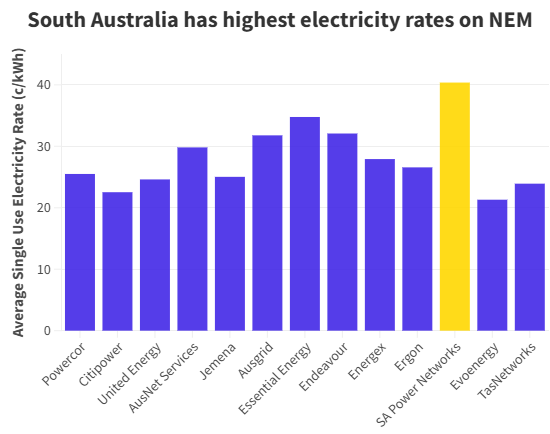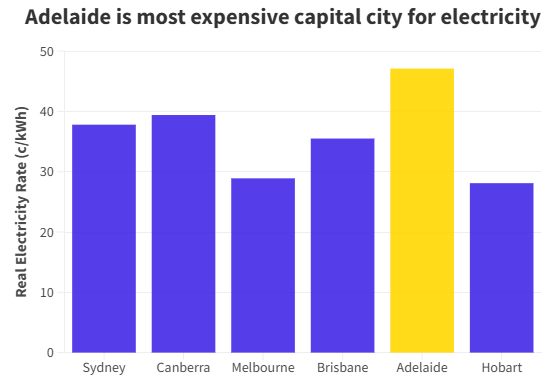South Australia is regarded as the nation’s leader in renewable energy, with the highest penetration of wind and solar generation in the country.
South Australia closed its last coal-fired power plant in 2016 and now generates more than three-quarters of its electricity from wind and solar.
However, the shutdown of its baseload coal power plants has left the state largely reliant on costlier sources, including gas, batteries, and diesel, which has raised the average wholesale electricity rates in the state.
The high costs of building renewable transmission have also been capitalised into retail power bills.
The end result is that South Australians pay the highest electricity rates in the country.
“South Australia has the highest electricity rates on the NEM, at over 40 c/kWh for single use rate plans. This is 49% higher than the average of the rest of the NEM”, according to Energyse.

Source: Energyse
“Adelaide is the capital city with the most expensive electricity, with electricity costing 47.1 c/kWh for a typical two person household once daily usage charges are factored in”.

Source: Energyse
South Australia had set a target to produce 100% net renewable energy by 2027, which would require closing the state’s gas-fired and diesel generators.
Given that wind and solar generation are completely dependent on the weather, policymakers clearly gave no consideration to how such a policy would operate in practice.
In times of low wind and solar generation, which happens regularly, South Australia would be exposed to blackouts.
In fact, the state would have experienced regular blackouts already were it not for the importation of electricity from Victoria, which is overwhelmingly generated from cheap brown coal supplemented by expensive gas.
Last month, the South Australian government delayed its gas closure plan by asking energy retailer AGL to extend the life of its ageing Torrens Island gas generator by two years amid warnings by the energy market operator that its scheduled closure would pose energy risks for the state.
The Australian Energy Market Operator warned that the planned closure of the 800-megawatt gas generator in June 2026 could lead to a 390-megawatt power shortfall in South Australia by 2026.
This week, South Australian Premier Peter Malinauskas addressed the Energy Nation conference, where he emphasised the vital role of gas in Australia’s energy mix.
Malinauskas argued that gas is essential to the firming of the nation’s electricity system and that without firming, there are no renewables. He also stressed the need to proceed with Santos’s Narrabri gas project in NSW, which has been repeatedly stalled by legal challenges and regulatory delays.
“For the sake of the economy and our decarbonisation aspirations, our nation needs a lot more gas, and we need it urgently”, Malinauskas said.
“The eco-purists who fill Instagram with creeds demanding an end to gas production, they should be careful what they wish for. And for the rest of us, are we going to let energy policy in our country be determined by the socials or by the science?”.
“If there’s gas out there, this is the time to get it out of the ground, and Narrabri presents the most immediate and important opportunity for our nation to secure our domestic gas supply, the supply that we need to navigate the energy transition”.
“Batteries have got an important role to play within the stabilization of the grid, and we shouldn’t dismiss or discount the role of batteries … but ultimately, for the big scale, battery technology alone is not going to be able to firm the grid in the grid in the way that is necessary, which is why you’ve got to have gas generation”, he said.
Hilariously, Malinauskas still spruiked that South Australia will become 100% renewable, despite being heavily reliant on gas and brown coal generation imports from Victoria.
“In South Australia, 80% of our electricity now is generated through renewables, and we’re on track to hit 100% net renewables by the end of 2027″, Malinauskas said. “Now, this achievement has only been possible because of the capacity of gas to firm our grid”.
Clearly, South Australia is only 100% renewable so long as it can import fossil fuel power from other states.
However, Victoria has set a binding target to generate 95% of its electricity from renewables by 2035, which will remove brown coal from the equation. Other states have set similar (albeit less severe) emissions reduction targets.
What happens when all of Australia follows South Australia down the renewables path? Answer: energy costs will soar.

